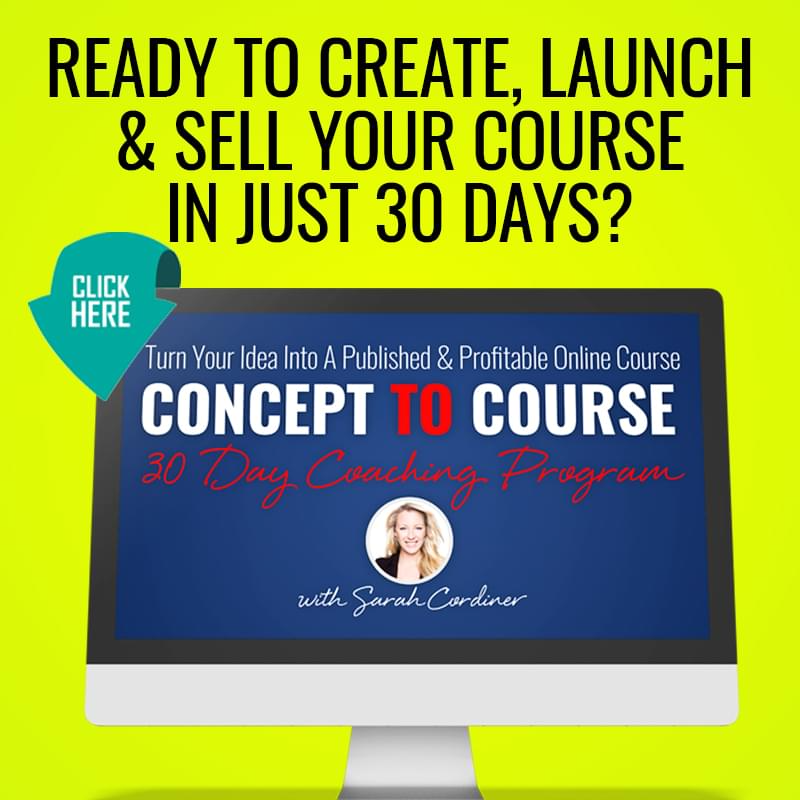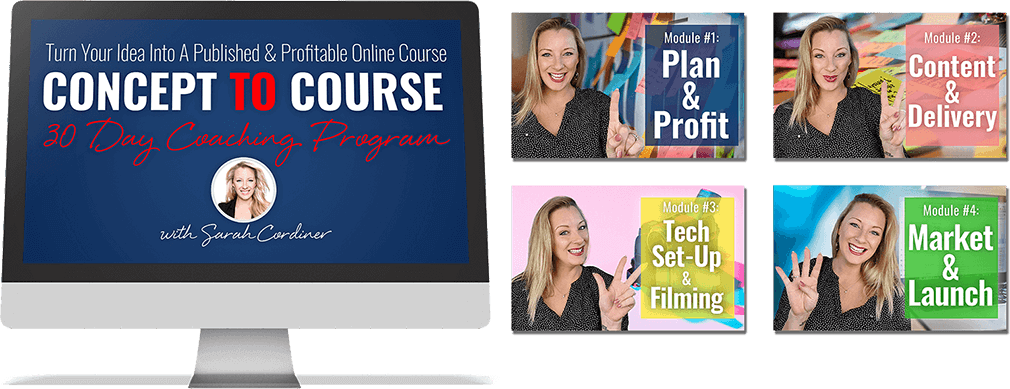Step 2 Of 10
Step 2: How To Ensure That Your Online Course Idea Has High Market Demand
Written by Sarah Cordiner
Welcome back, hope you had a great brainstorming session yesterday coming up with the perfect online course topic!
NOW…… Hands up who wants to create an online course that NOBODY will ever buy??
**Nope. Didn’t think so**
That’s why Step 2 of creating an online course is so critical……
Today we are going to take that idea or ideas if you are still deciding, and I am going to share a couple of very simple little techniques that you can do today, to check whether your course idea is likely to sell.
That is, ‘does your online course idea have high market demand?’
It was quite some time ago that I decided I wanted to be an ‘Edupreneur’ – to start my own business educating others.
It was a freezing winters day in the UK. The kind of day with sideways rain and pitch blackness by 3pm.
But this was a day that I didn’t notice the bitter misery. I was too excited about my brand new business idea.
I excitedly ran home to tell my partner at the time ‘I’m going to be an entrepreneur!!’
He paused his TV show, smiled at me, and said “Don’t come crying to me when it all goes wrong!”.
Annoyed and stinging, but not deterred; I drove to my Mums house as fast as I could and excitedly told her “mum mum mum, I’m going to be an entrepreneur!!”
She took a long puff on her cigarette as she contemplated my news, looked at me like I’d just pooped in her coffee and squawked “What the hell is wrong with you Sarah?! Get your head out of the clouds and get a real job! And don’t come crying to me when it all goes wrong!”
Double ouch.
At first the doubt of those I loved the most crippled my self-belief and wondered if they were right.
My idea was stupid. I’d be a failure. Nobody would want to buy what I had to offer.
I sought out comfort in a friend and shared my business idea with her, tears falling into my over-filled glass of red wine. “OMG Sarah, that’s a total CASH COW mate! You’d absolutely KILL IT! It’s a great idea, go for it!”….
I was completely conflicted.
Who was right?
Who should I listen to?
How could I know if it was worth leaving my well-paid Training Management job to pursue this dream without putting myself at risk of financial obliteration?
Only a couple of years on from that day, I had run my education company in 3 different countries, had employed over 50 full time employees, hundreds of contractors, been the catalyst of the education of thousands of people globally and had an asset worth millions of dollars.
Needless to say, my mum is now my BIGGEST fan – and my ex is totally kicking himself! (haha).
But how did I decide what to do??
The fact is, if I’d listened to EITHER my ex, my mum or my friends; I’d have failed.
The ONLY way that you can get the best assurance of success in ANY business venture or activity, is to assess whether or not there is a market demand for it.
So what exactly is market demand?
I know it seems pretty obvious right? But in fact the question as to whether your course topic will have high market demand isn’t as easy as believing it will or even your friends telling you that you have a great idea.
Like good friends and family, they will either share your excitement and give the supportive nod of, “that’s amazing, you should totally do it… I would buy it!”… OR, they will judge YOUR idea against their OWN capabilities and tell you it can’t be done.
None of which have ANY consideration of what your BUYERS actually think of your idea.
Just because they say ‘I would buy it’, doesn’t mean they actually will, nor does it mean that they are your target customer – which makes their input valuable, but not actually valid when it comes to assessing the viability of your concept.
If you’re going test your idea, stop asking your friends (or anyone who is not your market) if they ‘would’ buy it, and start asking them to actually buy it!
Better yet, find your actual market and get real customers to buy it.
There’s a big difference in ‘I would do it’ versus someone actually pulling out their credit card.
You need to know that your product causes people to pull their credit card and not just smile at your idea.
SO many of the clients I work with come to me with a course idea; and by the time I have taken them through my business model profitability process, perfect course topic selection process and my market testing strategies (all of which my ‘Concept To Course’ students get coached through by me personally), many completely change their course ideas and many have even completely altered their entire businesses.
Check out what Lorraine had say on this from the last ‘Concept To Course’ group who managed to create TWO online courses based on two of her different skills sets that she used my strategies to match up to a high niche market demand each:

There are 4 key things that you MUST check your online course idea against before you risk wasting your precious time and effort creating something that nobody is going to buy.
You can consider your online course idea as having a positive market demand if:
1. People want to buy it
2. People are asking questions about it
3. People are talking about it
4. It’s a topic ‘trending upwards’ in online searches
There are many ways to run each of these tests and I cover them ALL in full step by step detail with my coaching clients in my ‘Concept To Course’ program, however here are a couple of super simple market testing techniques just to get you started:
First, take your list of potential topics. Then, think about the terms, keywords and phrases that your target customer would be likely to type into Google to find information (like your course) on that topic.
These are most likely to be phrases that begin with ‘How to (your topic/keyword)’.
For example, if you want to teach people how to sell their own clothing line on Etsy, you want to search “selling clothes on Etsy” and similar topic searches like “how to design your own clothes” – you get the point.
When you start typing in your keywords and phrases, Google will ‘auto-fill’ the search bar with suggested other searches for you.
These auto-filled suggestions are actually the top search terms that have recently been typed into Google by the masses with those keywords.
Pay LOTS of attention to these!
If this is what people have been typing into Google, then THIS is what people are asking questions about and searching for answers on.
These are the things that have high market demand.
After searching all of your various keywords and key phrases (as well as those being suggested by Google auto-fill); then look for what the top adverts are on the first page of Google for each search and do some ‘nosing about’.
These paid adverts and top search results on page one of your searches are a valuable part of your research.
The reason you want to pay attention to the paid ad spots is that if other people are paying to have their courses and learning products show up in your results, OR their pages are so popular that they are coming up trumps in Google, then you’ve got a very good sign that there is a positive market demand in that topic.
If there are competing courses in the same topic as you, it’s actually a great thing because it means that there are people interested in your topic.
There are lots of ways to differentiate your course and make yours better than the competition (which I go into in the ‘Content Creation’ stage of my ‘Concept To Course‘ program) – so please do NOT be put off by competition.
There is little in todays world that’s completely original; therefore, if there was NO competition whatsoever, then I would want to do some further research into whether there is any demand for it.
Go to some of the popular online course marketplaces, such as Udemy.com and do a search on your course topic.
Assess the level of competition, look at the number of students enrolled, the price, the curriculum content. Lots of competition and activity in your topic is a GOOD sign of high market demand.
Another great place for investigating the viability of your online course is YouTube.
Just like the Google search bar, YouTube also has auto-fill suggestions based on what people have been searching for on the platform.
The keywords and phrases that come up here as well as a high volume of video results with large view numbers in your topic are again signs of positive market demand.
If your topic is being searched out by others, you have a great topic.
Finally, go to ‘Google Trends’ and type in your topic. This will tell you whether searches on the internet in those keywords or phrases are going up or going down.
If the searches are trending upwards, then your course idea has signs of being in high market demand.
It’s better to be the biggest fish in a smaller pond, than just another shrimp in the ocean.
Once you have established that your topic is being talked about, people are asking lots of questions about it and that it is trending; now you want to niche it down to be targeted at a very specific group of people.
So with our Etsy clothing line example, instead of your course being “how to sell clothes on Etsy”; you could niche it to “how to have a sell-out activewear business on Etsy”.
Instead of having a course on “Facebook adverts” which is a highly competitive field that you’d drown in; instead niche it to “Facebook ads for Authors” for example – where you’d have a much higher chance of becoming a specialist leader.
See the difference?
The more you niche, the more you can stand out and dominate.
Now there are actually much more in-depth market tests that must be done if you want to ENSURE that your course idea has high market demand.
Those listed above are only a couple of very easy little testers to get you going.
If you’re an action-taking DOER like me and want to get the full set of market testing strategies that I use for all of my 6 and 7 figure courses;
you’ll want to grab one of the 30 places on my next ‘Concept To Course: 30 Day Course Creation Group Coaching Program‘ (starting on 1st March) where we will go through every step for checking that your course idea(s) has high market demand, so that you can be CERTAIN that you have the maximum chances of a profitable online course success.
Just yesterday, I opened the doors to my exclusive 30 day coaching program ‘Concept To Course‘ where I literally take you by the hand for 30 days and personally guide you to create, launch and sell your course in just 4 weeks!
This coaching program is extremely limited in space and the doors will only be open for a short time until we sell out – with the group training starting in just A COUPLE WEEKS from now!
Tomorrow I’m going to send you tips and strategies for: Step 3 of creating an online course; which is “How to Price Your Course and Nail Your Business Model“.
Talk tomorrow!

NOW YOU’RE READY TO LEVEL UP…

Learn more about my coaching program Concept To Course: 30 Day Course Creation Group Coaching Program, where I personally help you turn your course idea into a profitable and published online course in just 30 days!
Sarah Cordiner (MainTraining Pty Ltd) | Copyright ©2020 | All Rights Reserved
